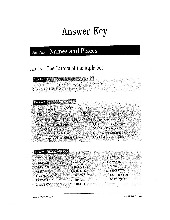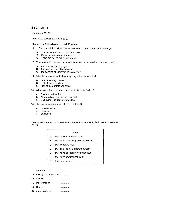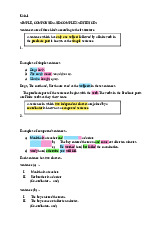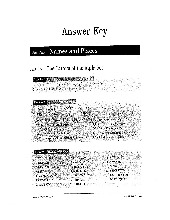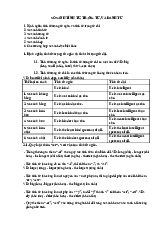



Preview text:
lOMoAR cPSD| 40342981
### Exercise: Semantics Practice - Chapter 1, 2, 3 #### Part 1: Theory **Task 1: True or False?**
1. Semantics studies the meanings of linguistic expressions in context. F
2. The meaning of a content word is a concept that provides a mental description for a certain kind of situation. F
3. The process of composition is a top-down process. F
4. The proposition is the descriptive meaning of the sentence. T
5. According to the Principle of Compositionality, the meaning of a complex expression
is determined by linguistic input only. T
6. All lexemes are single words. F
7. An expression or an utterance is ambiguous if it can be interpreted in more than one way. T
8. Content words are the main carriers of information in a sentence. T
9. Two lexemes are homonymous if they have two or more interrelated meanings with each other. F
10. Utterance meaning derives from expression meaning on the basis of the particulars
provided by the context of utterance. T
11. Utterance meaning is the meaning of an utterance as a communicative act in a given
social setting. F Communicative meaning
12. The meaning resulting from the process by which we calculate the meaning of a
sentence is known as grammatical meaning. F Compositional meaning
13. Connotation is the use of roughly good or indirect terms for bad or taboo things. F euphenism
14. Expressive meaning is the indication of social relations and performance of social acts. F Social meaning
15. All categories of lexemes have just one form. F
16. The expression “the best pen” in “He is the best pen of the day” is a metonymy. T
17. The expression “my school” has co-reference. F Variable reference
18. In metaphors, function words are used. T lOMoAR cPSD| 40342981
19. The expression “The kettle” in “The kettle is boiling” is metaphor. T
20. The expression “the United Nations” has constant reference. F
21. The context of utterance includes the speaker, the addressee, the time, the place, and the facts. T
22. The entity referred to by an expression is called its reference. F referent
23. Meaning of “long” or “short” is vague. T
24. Words such as “darling” and “baby” have social meaning. T
25. The relation between "can" (a metal container) and "can" (able to) is polysemy. F
**Task 2: Complete the Sentences**
1. “My mother is a teacher.” In this expression “my mother” has variable reference.
2. A referent is an object or an entity in the real world or in the world of your imagination.
3. A lexeme is polysemy if it has two or more interrelated meanings.
4. A lexical meaning is vague if it allows for flexible adaptation to the given CoU.
5. According to the principle of compositionality, the meaning of a complex expression
is determined by the lexical meanings of its components, their grammatical
meanings, and the syntactic structure of the whole.
6. An expression is used metaphorically if it is used to refer to things that are in crucial
aspects similar to the kind of objects to which the expression refers in its literal meaning.
7. Communicative meaning is the meaning of an utterance as a communicative act in a given social setting.
8. Expression meaning is the meaning of an expression taken in isolation
9. The communicative act of the utterance “Tidy your room.” is a request.
10. The denotation of a content word is the category, or set of all its potential referents.
11. The descriptive meaning of a content word is a concept for its potential referents. True or False: True
12. The descriptive meaning of a sentence, its proposition, is a concept that provides a
mental description of the kind of situations it potentially refers to.
13. The meaning of a content word is a concept that provides a mental description of a lOMoAR cPSD| 40342981 certain kind of entity.
14. Two lexemes are totally homonymous if they have unrelated meanings but share all
other constitutive properties.
**Task 3: Define the following terms.** 1. Homonymy: 2. Polysemy 3. Metonymy 4. Metaphor
5. Principle of Compositionality 6. Utterance meaning 7. Expression meaning 8. Lexical meanings 9. Compositional meaning 10. Speech act theory #### Part 2: Practice
**Task 1: Identify the relation between the following pairs of lexemes.**
1. Light (in "light blue") and light (in "light breakfast")
2. Sound (in "He tried not to make a sound") and sound (in "He gave me some very sound advice")
3. Tear (in "Upon seeing the tear in the painting I shed a tear") 4. Week and weak
5. Punch (a blow with the fist) and punch (an iced mixed drink usually containing alcohol)
6. File (a set of related records kept together) and file (a steel hand tool with small sharp teeth)
7. Steel (an alloy of iron with a small amount of carbon) and steel (to get ready for
something difficult or unpleasant)
8. Fan (a device for creating a current of air by movement of a surface) and fan (an ardentfollower or admirer) lOMoAR cPSD| 40342981
9. Tail (the posterior part of the body of a vertebrate) and tail (a spy employed to follow
someone and report their movements)
10. Date (sweet edible fruit of the date palm) and date (a meeting arranged in advance)
11. Blind (unable to see) and blind (a protective covering that keeps things out or hinders sight)
12. Tie (a neckwear consisting of a long narrow piece of material tied in a knot at the
front) and tie (to fasten or secure with a rope string or cord)
13. Graze (feed as in a meadow or pasture) and graze (break the skin by scraping)
**Task 2: Analyze the sentences**
1. The expression "a demon for work" in the sentence "The man is a demon for work."
2. The expression "The White House" in the sentence "The White House decided to reopen schools this fall."
3. The expression “The sun” has constant reference.
4. The meaning relation between "broad" and "wide".
5. The meaning relation between "single" and "married".
6. The expression “the best pen” in “He is the best pen of the day.”
7. The meaning of the phrase "light breakfast."
8. The context of the utterance "I'm thirsty."Good luck with your exercises!
